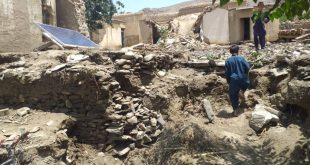By Akhtar M. Nikzad:
Three decades of chaos in Afghanistan, poverty, lawlessness, social taboos, sexual prejudice and culture of impunity are the major factors that impede the drive to end violence against women.
Violence against women is one of the important issues that had earned bad image for the Afghan society, even in the post-Taliban era girls are prone to domestic violence and harassment at workplaces. Despite efforts of the national and international human rights organizations there is no end in sight to the violence against the already depressed folk. Violence against women and girls remained as major problem in Afghanistan but result-oriented strategies are missing from the table. According to the Ministry of Women Affairs, (MoWA) in 2012 around 4,505 cases of violence against women were registered. Number of the cases reached to 5,406 in 2013. In the first eight months of the current solar year around 2,500 cases of violence were reported. According to the ministry, majority of the cases are related to torture and murder of women.
Obsolete centuries-old social norms are not solely responsible for the violence, but lack of public awareness about women’s rights, delay in approval of the Law on Elimination of Violence against Women, poverty and flawed justice system are also making part of the root cause.
Acting Minister of MoWA, Sayeda Mujhgan Mustafawi, believes that implementation of Law on Elimination of Violence against Women, cooperation between organizations working for supporting women rights, establishment of women courts for prosecuting violence cases could help the Afghan government to reduce tame the beast of violence.
“To end violence against women we need tireless efforts and long time, especially wholeheartedly cooperation of the national and international rights groups,” she said.
Chairperson of the Independent Human Rights Commission, Sima Samar, said that gender- based violence has not decreased in the country, but public awareness raised few notches as several cases of violence against girls and women were registered in different women’s rights supporting organizations.
So far around 13 organizations are working for women’s rights but still violence against women is widespread. Now the question flares that why the rights groups have failed. Who knows better this than young educated Afghan girls.
A number of young girls told Afghanistan Times that majority of women’s rights supporting agencies were focusing on the capital city while widespread violence against women and girls exists in provinces where women’s rights is not more than a myth.
Mariam Urizgani said that women’s rights supporting agencies that get funds from donors implement their programs in Kabul City where women already enjoy their rights and are not prone to violence. She said that rights groups and the government speak of violence against women until they spend the donations, once they run out of money they no more talk of rights or awareness drives.
“I think women’s rights can be restored if the rights organizations worked honestly and refrained from initiating short-term projects because change never comes in months or weeks but take long time and hard work. I thing violence against women is not a new phenomena in the country. On the other hand the data regarding violence against women provided by media and the Ministry of Women Affairs is not representing the ground reality. Thousands of women are barred from reporting violence cases. One cannot exactly say about percentage of violence unless there is complete and credible date. Therefore, first we need to find out exact number of violence cases,” she opined.
Apparently, the women affairs ministry has done much for reducing violence against women such as approval of the Family Law, awareness workshops and establishment of shelter houses. However, these steps are not adequate. Other relevant organizations and religious scholars should launch comprehensive awareness drives across the country, Urizgani said while looking concerned about miseries of her folk.
Lambasting the non-governmental organizations (NGOs) for the alleged double standard and waste of resources, she said the government should strictly monitor the NGOs aimed at ensuring that hard-earned money of donors and tax-payers have not been misused. “Transparency in spending of the NGOs must be ensured as it is vital for women’s rights protection,” she said.
According to Hosai Azizi, a resident of Kabul City, there two types of violence against women found in most parts of the country. “One is domestic violence. It is mostly about family members and relatives while the other type of violence is committed by non-state actors. Domestic violence tops the list because the government does not interfere in family affairs of citizens,” the underlined
She asked the government to educate people at family-level. Azizi said that men and women both are equal before the law, that’s why the authorities shall take rights of women seriously to end discrimination.
Regarding role of NGOs she said that some civil rights groups claiming working for women’s rights were promoting strange culture which is against Islamic values which was another cause of violence in the society.
“All the time we hear charming slogans of the government and so-called non-profit organizations regarding protection of Afghan women’s rights but on the ground situation has not been changed at all. The government and rights groups shall work together to find out why there is violence against women and girls and how can they fight it effectively,” said Madiha Mujhgan, another resident of the capital city.
When asked about causes of violence she said that social taboos and personal interests of the lawmakers were main reasons behind harassment and torture of womenfolk. “Delay in approval of the Law on Elimination of Violence against Women, economical problems in the family, forced marriages, early marriages, insecurity and gray areas in the judicial system are the factors that I have to blame for violence against women,” Mujhgan opined.
Self-immolation, chopping of body parts, physical and mental torture, restrictions on access to health and education facilities are the most dangerous cases of violence against women that took place in the last few years. According to the reports, the domestic violence influence 10 percent children and 90 percent women.
 Afghanistan Times
Afghanistan Times




